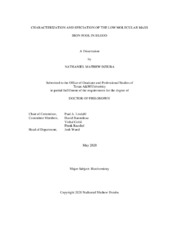| dc.description.abstract | The foci of this work were in characterizing and speciating the low molecular mass (LMM) iron pool in blood. We operationally define this pool as non-proteinaceous iron species with masses <10 kDa. In iron overload disorders (e.g., hemochromatosis) some portion of this pool is involved in organ damage and is termed non-transferrin bound iron (NTBI). NTBI has been poorly characterized and is thought to be ferric citrate. The blood’s major iron transport protein, transferrin (Tf), is typically 30% saturated; when saturation levels are elevated, NTBI concentrations typically increase due to the unregulated trafficking of iron into the blood. The first part of this work involves work done on characterizing the LMM pool of iron in blood. Characterization (i.e., mass, concentration, number of species, chemical identity) of the LMM pool of iron was performed using an anaerobic and chilled liquid chromatography system, coupled to an inductively coupled plasma mass spectrometer (LC-ICP-MS). Flow-through solutions (FTS) from filtered plasma were injected onto a size-exclusion column (SEC). In the second part of this work, the intact circulatory and digestive system of an iron-deficient pig was used to detect endogenously formed NTBI by tracing labeled nutrient iron (57FeII-ascorbate). Blood was sampled from before and after the liver to observe NTBI formation and the effect of the liver via LC-ICP-MS.
Two to six conserved LMM species with apparent masses ranging from 400- 2500 Da and concentrations ranging from 10-100 nM were detected in blood from various healthy mammals and hemochromatosis (HC) humans. Of these, the species in the 400 -500 Da range were the most reproducible. HC human FTS did not show any difference relative to that of a healthy human, possibly due to the treatment of their disease. Comparison of the observed species in FTSs with ferric citrate standards showed similar, though not identical, elution profiles. Ferric citrate was not the predominate species in healthy blood plasma, though it could be a constituent. 57Fe traced nutrient iron was predominately bound to Tf with no detectable intermediates, suggesting that nutrient iron is channeled to Tf with forming stable-intermediate species. Endogenous (56Fe) LMM iron species were observed with masses ranging from 400- 1600 Da. The liver both absorbed and released LMM iron species to a modest degree, indicative of its role in iron metabolism. The endogenous species detected are thought to be generated from red blood cell recycling. | en |


